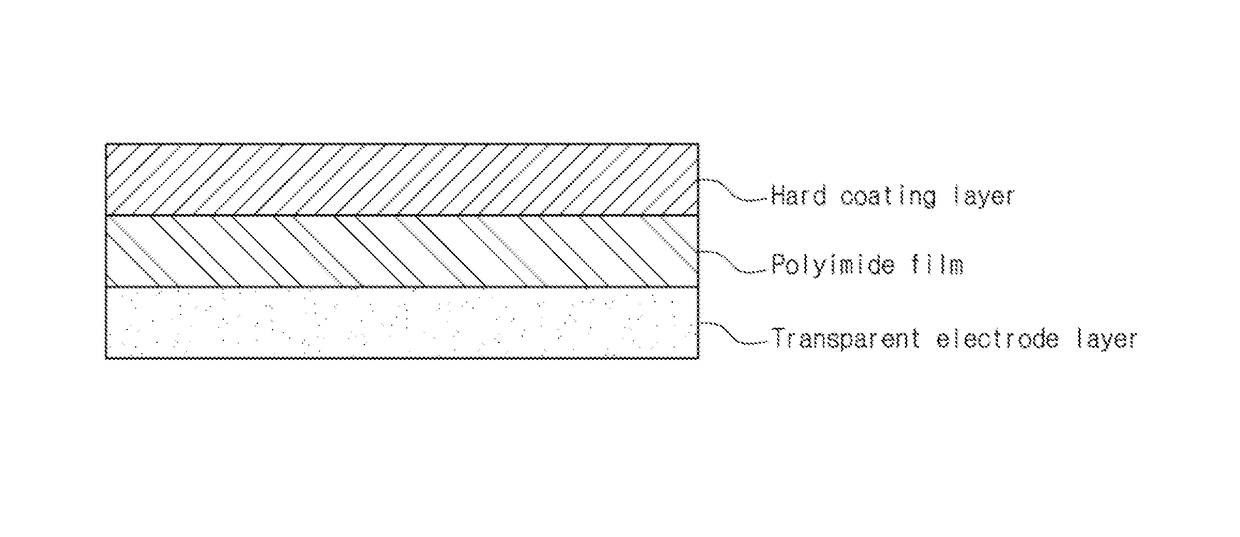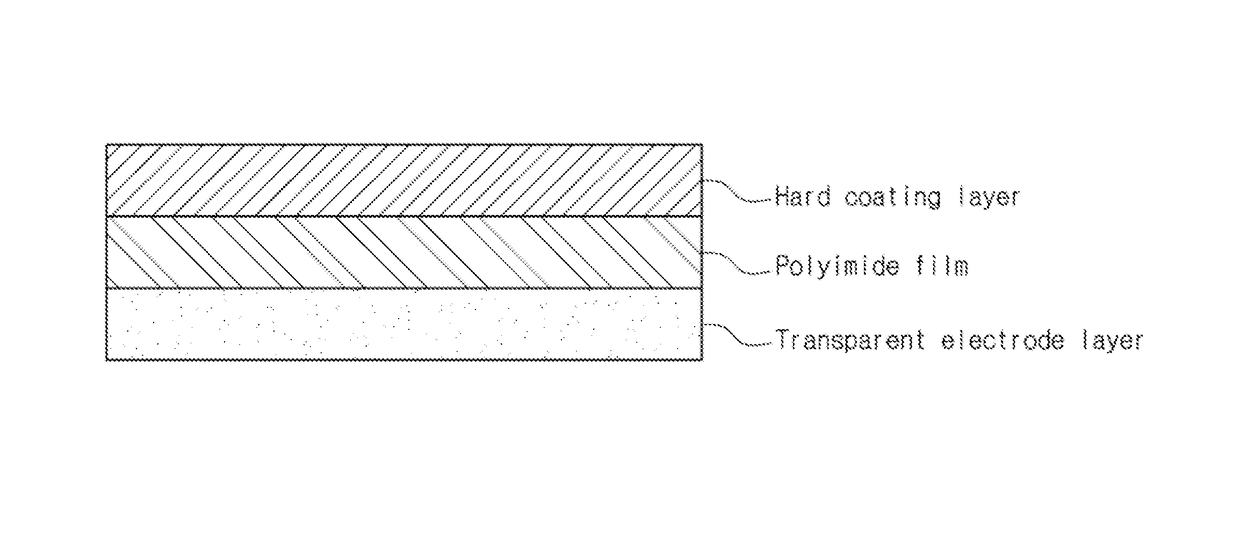Plastic substrate, method for producing the same and touch screen panel containing the same
a technology of touch screen panel and substrate, which is applied in the direction of conductive layers on insulating supports, synthetic resin layered products, metallic pattern materials, etc., can solve the problems of low response speed, one point and is in danger of being damaged, and difficulty in mounting, so as to simplify the structure of the touch screen panel, the effect of low surface resistance and high hardness characteristics
- Summary
- Abstract
- Description
- Claims
- Application Information
AI Technical Summary
Benefits of technology
Problems solved by technology
Method used
Image
Examples
examples 1 to 3
[0060]As a reactor, a 100 mL 3-neck round-bottom flask provided with a stirrer, a nitrogen injector, a dropping funnel, a temperature controller and a cooler was filled with 28.78 g of N,N-dimethylacetamide (DMAc) while supplying nitrogen, and then cooled to 0° C., and then 3.2023 g (0.01 mol) of 2,2-TFDB was dissolved in DMAc to prepare a solution, and then this solution was maintained at 0° C. Then, 0.88266 g (0.003 mol) of BPDA was added to the solution and stirred for 1 hour to completely dissolve BPDA, and then 3.10975 g (0.007 mol) of 6FDA was added and completely dissolved. In this case, the concentration of solid matter in the resultant solution was 20 wt %. Thereafter, this solution was stirred at room temperature for 8 hours to obtain a polyamic acid solution having a solution viscosity of 2100 poise at 23° C.
[0061]Subsequently, 2˜4 equivalents of acetic anhydride (acetic oxide, manufactured by Samjeon Co., Ltd.), as a curing agent, and 2˜4 equivalents of pyridine (manufac...
example 4
[0065]As a reactor, a 100 mL 3-neck round-bottom flask provided with a stirrer, a nitrogen injector, a dropping funnel, a temperature controller and a cooler was filled with 28.78 g of N,N-dimethylacetamide (DMAc) while supplying nitrogen, and then cooled to 0° C., and then 3.2023 g (0.01 mol) of 2,2-TFDB was dissolved in DMAc to prepare a solution, and then this solution was maintained at 0° C. Then, 0.88266 g (0.003 mol) of BPDA was added to the solution and stirred for 1 hour to completely dissolve BPDA, and then 1.33275 g (0.003 mol) of 6FDA was added and completely dissolved. Then, 0.8121 g (0.004 mol) of TPC was added to the resultant solution to obtain a polyamic acid solution having a solid content of 15 wt %.
[0066]A plastic substrate film was formed in the same manner as in Example 1 using the obtained polyamic acid solution.
[0067]The thicknesses of the polyimide film, hard coating layer and ITO electrode layer obtained in Example 4 are summarized in Table 1 below.
example 5
[0068]A polyamic acid solution was prepared in the same manner as in Example 1, except that 6FCDA (9,9-bis(trifluoromethyl)-2,3,6,7-xanthene tetracarboxyl dianhydride) was used as a composition for preparing the same instead of 6FDA. Then, a plastic substrate film was formed using the prepared polyamic acid solution in the same manner as in Example 1.
[0069]The thicknesses of the polyimide film, hard coating layer and ITO electrode layer obtained in Example 5 are summarized in Table 1 below.
PUM
| Property | Measurement | Unit |
|---|---|---|
| light transmittance | aaaaa | aaaaa |
| yellowness | aaaaa | aaaaa |
| thickness | aaaaa | aaaaa |
Abstract
Description
Claims
Application Information
 Login to View More
Login to View More - R&D
- Intellectual Property
- Life Sciences
- Materials
- Tech Scout
- Unparalleled Data Quality
- Higher Quality Content
- 60% Fewer Hallucinations
Browse by: Latest US Patents, China's latest patents, Technical Efficacy Thesaurus, Application Domain, Technology Topic, Popular Technical Reports.
© 2025 PatSnap. All rights reserved.Legal|Privacy policy|Modern Slavery Act Transparency Statement|Sitemap|About US| Contact US: help@patsnap.com


